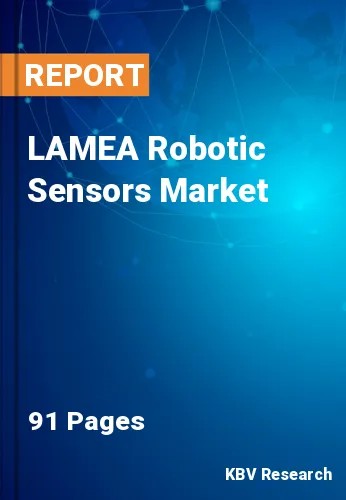
The Latin America, Middle East and Africa Robotic Sensors Market would witness market growth of 13.4% CAGR during the forecast period (2022-2028).
The process of automatically locating a robot in a complicated environment is known as localization. The process of localization depends on what is known as landmarks that could be either naturally occurring landmarks or purposefully put landmarks. In the first method, a robot's sensor picks up signals from artificial landmarks or beacons placed around it to pinpoint its precise location. Doors, walls, windows, and other natural landmarks could be detected by a robot's sensor or visual system (Camera). Beacons that produce Wi-Fi, Ultrasound, Bluetooth, radio waves, Infrared, Visible Light, or any other comparable signal could be used for localization.
Electronic circuits called current sensors detect the passage of current in a circuit and produce either a proportionate voltage or a current. The analogue voltage that most existing sensors produce which ranges from 0 to 5 volts, could be further analyzed by a microcontroller. Nowadays, hundreds of sensors are produced to detect almost anything people can imagine, making it nearly hard to list them all. Humidity sensors monitor humidity, and gas sensors are made to identify specific gases. Magnetic Field Sensors measure the intensity of the magnetic field around it, whereas potentiometers could be employed in a wide range of applications.
Applications that are correctly filled out improve the calibre of goods produced. One of the primary justifications for automating using industrial robots is frequently the production of uniform, high-quality products. Force sensors could assist in determining the exact amount of pressure to provide to a workpiece when a FANUC M-710ic/50 is used for grinding, limiting the removal of too much or too little material. All components receive the same amount of stress, resulting in workpieces that are uniform and smooth. By preventing items from differing from one another, having flaws, or being damaged, force feedback considerably raises the standard of manufacturing.
Two economies that are still in the early stages of technology adoption and development are those in Africa and the Middle East. On the other hand, the region's economic outlook is unfavorable and would primarily depend on how well private and public sector initiatives and investments perform. Additionally, a lot of businesses in this region are implementing cutting-edge automation tools like packaging robots to cut costs and improve operational effectiveness. In addition, the rapid adoption of automation across various verticals would create more demand for robots as well as robotic sensors.
The Brazil market dominated the LAMEA Robotic Sensors Market by Country in 2021, and would continue to be a dominant market till 2028; thereby, achieving a market value of $54.2 million by 2028. The Argentina market is experiencing a CAGR of 14% during (2022 - 2028). Additionally, The UAE market would display a CAGR of 13.1% during (2022 - 2028).
Based on Vertical, the market is segmented into Manufacturing, Logistics, Aerospace & Defense, Healthcare, and Others. Based on Type, the market is segmented into Force (Torque) Sensor, Proximity Sensor, Position Sensor, Vision Sensor, Temperature Sensor, and Others. The report also covers geographical segmentation of Robotic Sensors market. Based on countries, the market is segmented into Brazil, Argentina, UAE, Saudi Arabia, South Africa, Nigeria, and Rest of LAMEA.
Free Valuable Insights: The Global Robotic Sensors Market is Predict to reach $3.1 Billion by 2028, at a CAGR of 10.2%
The market research report covers the analysis of key stake holders of the market. Key companies profiled in the report include TE Connectivity Ltd., Infineon Technologies AG, Omron Corporation, Honeywell International, Inc., ATI Industrial Automation, Inc., FANUC Corporation, Sensata Technologies Holdings PLC, Baumer Holding AG, Tekscan, Inc., and FUTEK Advanced Sensor Technology, Inc.
By Vertical
By Type
By Country
Our team of dedicated experts can provide you with attractive expansion opportunities for your business.
